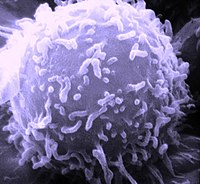
Photo from wikipedia
Purpose: Malignant progression exhibits a tightly orchestrated balance between immune effector response and tolerance. However, underlying molecular principles that drive the establishment and maintenance of the tumor immune phenotype remain… Click to show full abstract
Purpose: Malignant progression exhibits a tightly orchestrated balance between immune effector response and tolerance. However, underlying molecular principles that drive the establishment and maintenance of the tumor immune phenotype remain to be elucidated. Experimental Design: We trained a novel molecular classifier based on immune cell subsets related to programmed death-ligand 1 (PD-L1) and interferon γ (IFNγ) expression, which revealed distinct subgroups with higher (cluster A) or lower (subcluster B3) cytotoxic immune phenotypes. Integrative analysis of multi-omics data was conducted to identify differences in genetic and epigenetic landscapes as well as their impact on differentially expressed genes (DEG) among immune phenotypes. A prognostic gene signature for immune checkpoint inhibition (ICI) was established by a least absolute shrinkage and selection operator (LASSO)-Cox regression model. Results: Mutational landscape analyses unraveled a higher frequency of CASP8 somatic mutations in subcluster A1, while subcluster B3 exhibited a characteristic pattern of copy-number alterations affecting chemokine signaling and immune effector response. The integrative multi-omics approach identified EGFR and PTGS2 as key nodes in a gene regulatory network related to the immune phenotype, and several DEGs related to the immune phenotypes were affected by EGFR inhibition in tumor cell lines. Finally, we established a prognostic gene signature by a LASSO-Cox regression model based on DEGs between nonprogressive disease and progressive disease subgroups for ICI. Conclusions: Our data highlight a complex interplay between genetic and epigenetic events in the establishment of the tumor immune phenotype and provide compelling experimental evidence that a patient with squamous cell carcinoma of the head and neck at higher risk for ICI treatment failure might benefit from a combination with EGFR inhibition.
Journal Title: Clinical Cancer Research
Year Published: 2020
Link to full text (if available)
Share on Social Media: Sign Up to like & get
recommendations!